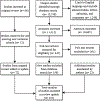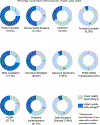Evidence for state, community and systems-level prevention strategies to address the opioid crisis
- PMID: 31585357
- PMCID: PMC9286294
- DOI: 10.1016/j.drugalcdep.2019.107563
Evidence for state, community and systems-level prevention strategies to address the opioid crisis
Abstract
Background: Practitioners and policy makers need evidence to facilitate the selection of effective prevention interventions that can address the ongoing opioid overdose epidemic in the United States.
Methods: We conducted a systematic review of publications reporting on rigorous evaluations of systems-level interventions to address provider and patient/public behavior and prevent prescription and illicit opioid overdose. A total of 251 studies were reviewed. Interventions studied included 1) state legislation and regulation, 2) prescription drug monitoring programs (PDMPs), 3) insurance strategies, 4) clinical guideline implementation, 5) provider education, 6) health system interventions, 7) naloxone education and distribution, 8) safe storage and disposal, 9) public education, 10) community coalitions, and 11) interventions employing public safety and public health collaborations.
Results: The quality of evidence supporting selected interventions was low to moderate. Interventions with the strongest evidence include PDMP and pain clinic legislation, insurance strategies, motivational interviewing in clinical settings, feedback to providers on opioid prescribing behavior, intensive school and family-based programs, and patient education in the clinical setting.
Conclusions: Although evidence is growing, further high-quality research is needed. Investigators should aim to identify strategies that can prevent overdose, as well as influence public, patient, and provider behavior. Identifying which strategies are most effective at addressing prescription compared to illicit opioid misuse and overdose could be fruitful, as well as investigating synergistic effects and unintended consequences.
Keywords: Opioid; Overdose; Policy; Prescribing; Prevention.
Published by Elsevier B.V.
Conflict of interest statement
Declaration of Competing Interest
No conflicts declared.
Figures




References
-
- Albert S, Brason FW 2nd, Sanford CK, Dasgupta N, Graham J, Lovette B, 2011. Project Lazarus: community-based overdose prevention in rural North Carolina. Pain Med. 12 (Suppl 2), S77–85. - PubMed
Publication types
MeSH terms
Grants and funding
LinkOut - more resources
Full Text Sources

